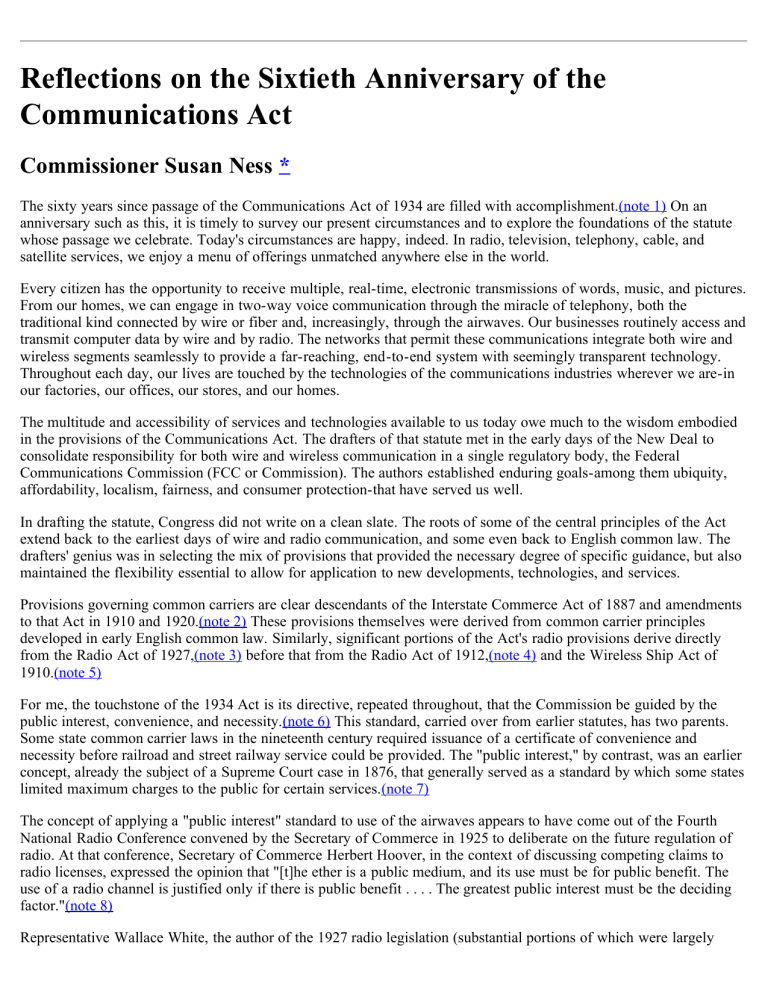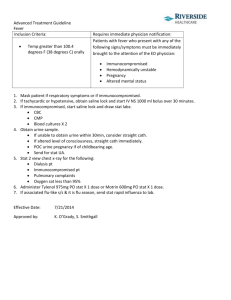Reflections on the Sixtieth Anniversary of the Communications Act

Reflections on the Sixtieth Anniversary of the
Communications Act
Commissioner Susan Ness
The sixty years since passage of the Communications Act of 1934 are filled with accomplishment.
anniversary such as this, it is timely to survey our present circumstances and to explore the foundations of the statute whose passage we celebrate. Today's circumstances are happy, indeed. In radio, television, telephony, cable, and satellite services, we enjoy a menu of offerings unmatched anywhere else in the world.
Every citizen has the opportunity to receive multiple, real-time, electronic transmissions of words, music, and pictures.
From our homes, we can engage in two-way voice communication through the miracle of telephony, both the traditional kind connected by wire or fiber and, increasingly, through the airwaves. Our businesses routinely access and transmit computer data by wire and by radio. The networks that permit these communications integrate both wire and wireless segments seamlessly to provide a far-reaching, end-to-end system with seemingly transparent technology.
Throughout each day, our lives are touched by the technologies of the communications industries wherever we are-in our factories, our offices, our stores, and our homes.
The multitude and accessibility of services and technologies available to us today owe much to the wisdom embodied in the provisions of the Communications Act. The drafters of that statute met in the early days of the New Deal to consolidate responsibility for both wire and wireless communication in a single regulatory body, the Federal
Communications Commission (FCC or Commission). The authors established enduring goals-among them ubiquity, affordability, localism, fairness, and consumer protection-that have served us well.
In drafting the statute, Congress did not write on a clean slate. The roots of some of the central principles of the Act extend back to the earliest days of wire and radio communication, and some even back to English common law. The drafters' genius was in selecting the mix of provisions that provided the necessary degree of specific guidance, but also maintained the flexibility essential to allow for application to new developments, technologies, and services.
Provisions governing common carriers are clear descendants of the Interstate Commerce Act of 1887 and amendments to that Act in 1910 and 1920.
(note 2) These provisions themselves were derived from common carrier principles
developed in early English common law. Similarly, significant portions of the Act's radio provisions derive directly from the Radio Act of 1927,
(note 3) before that from the Radio Act of 1912, (note 4) and the Wireless Ship Act of
1910.
For me, the touchstone of the 1934 Act is its directive, repeated throughout, that the Commission be guided by the public interest, convenience, and necessity.
This standard, carried over from earlier statutes, has two parents.
Some state common carrier laws in the nineteenth century required issuance of a certificate of convenience and necessity before railroad and street railway service could be provided. The "public interest," by contrast, was an earlier concept, already the subject of a Supreme Court case in 1876, that generally served as a standard by which some states limited maximum charges to the public for certain services.
The concept of applying a "public interest" standard to use of the airwaves appears to have come out of the Fourth
National Radio Conference convened by the Secretary of Commerce in 1925 to deliberate on the future regulation of radio. At that conference, Secretary of Commerce Herbert Hoover, in the context of discussing competing claims to radio licenses, expressed the opinion that "[t]he ether is a public medium, and its use must be for public benefit. The use of a radio channel is justified only if there is public benefit . . . . The greatest public interest must be the deciding factor."
Representative Wallace White, the author of the 1927 radio legislation (substantial portions of which were largely
reenacted as part of the Communications Act of 1934) expressed his agreement with the public interest principle during legislative debate on the Act. He observed:
[The Fourth National Radio Conference] . . . recommended that licenses should be issued only to those stations whose operation would render a benefit to the public, are necessary in the public interest, or would contribute to the development of the art. This principle was approved by every witness before your committee. We have written it into the bill. If enacted into law, the broadcasting privilege will not be a right of selfishness. It will rest upon an assurance of public interest to be served.
Later, Louis Caldwell, an early General Counsel of the Federal Radio Commission, presciently commented that the underlying theory of the public interest, convenience, or necessity standard is "perfectly sound; only an indefinite and very elastic standard should be prescribed for the regulation of an art and a field of human endeavor which is progressing and changing at so rapid a pace as is radio communication."
Reflecting upon the origins of the Communications Act is as useful, I think, in our deliberations regarding the future, as in our thoughts of the past. I am particularly interested in ensuring that "the public interest, convenience and necessity" standard is appropriately applied to today's and tomorrow's technologies and the services they make possible. The authors of the Communications Act gave us the "supple instrument" that enables us to do that.
Regulating in the public interest means deleting or updating unneeded and outdated regulations as much as it means implementing new regulations to govern new services and technologies.
I recently perused the Commission's January 1936 report to Congress on its first year of operations under the
Communications Act. Viewed through the prism of time, some aspects of the report seem distinctly quaint. Others have a much more familiar feel and illustrate ways in which the Commission was faced with challenges much like those presented today.
One section of the report addresses television broadcast technology in terms analogous to those we might use today with respect to high-definition television (HDTV):
The several companies carrying on the television experiments in the United States have not yet standardized the several essential elements of transmission. . . . No commercial receivers are at present available to receive such [high quality television] programs. In order to give television service it is necessary for the different manufacturing companies to standardize their transmissions and produce receivers which can receive all programs transmitted. In short, from a laboratory standpoint television programs can be satisfactorily transmitted and received locally at the present development of the art but before it is finally useful to the public there are many commercial problems to be solved.
The Commission and industry surmounted these problems and launched a new service which transformed our nation and the world.
It is a triumph that the standard they created has provided such an opportune mixture of constancy and change. The basic transmission parameters have held firm, avoiding disruption to consumers, but over the intervening years, enhancements such as color, stereo sound, and captioning have considerably enhanced the quality and utility of the service.
The report of the first year also reminds us that the Commission's tasks often involve highly technical or arcane matters, far removed from the marvels of new technologies. The first-year report mentions the investigation of affiliate relationships within telephone holding companies, an issue that has persisted through the years.
It also refers to cost allocations for telephone plant, noting that "[t]his problem is greatly complicated by the use in common of telephone plant for combinations of local exchange and toll service and the use in common of toll plant for rendering both intrastate and interstate toll service."
This issue arises today in our consideration of video dialtone-a new common carrier service that will provide a platform for telephone companies to deliver video and interactive programming to consumers. Though the service is new, the guiding principle for our decision making is not.
To reflect on the origins and early administration of the Communications Act of 1934 is to reaffirm the connection
between earlier eras and the present. Far from being ancient history, the 1934 experience remains intensely relevant today.
As a member of the Federal Communications Commission, I try to honor the "public interest, convenience, and necessity," and the principles these words represent, in every vote I cast. My fellow Commissioners and I strive to be as successful in our guardianship of public interest responsibilities as were the many distinguished public servants who preceded us. That is a humbling task, but a worthy endeavor.
*******
Notes
*Commissioner, Federal Communications Commission. B.A. Douglass College, Rutgers University, 1970; J.D.
cum laude Boston College Law School, 1974; M.B.A. Wharton School, University of Pennsylvania, 1983.
During the mid-1970s, the Author served as Assistant Counsel to the Committee on Banking, Currency, and
Housing of the U.S. House of Representatives. She later founded and directed the Judicial Appointments Project
of the National Woman's Political Caucus. Return to text
1. Communications Act of 1934, ch. 652, 602(a), 48 Stat. 1064 (codified as amended in scattered sections of 47
U.S.C. (1988 and Supp. IV 1992)).
2. Interstate Commerce Act of 1887, ch. 104, 24 Stat. 379 (codified as amended at 49 U.S.C. 10101-11917 (1988 and Supp. IV 1992)); see also 36 Stat. 539 (1910).
3. Radio Act of 1927, ch. 169, 44 Stat. 1162, repealed by Communications Act of 1934, ch. 652, 602(a), 48 Stat.
1064.
4. Act of Aug. 13, 1912, ch. 287, 37 Stat. 302, repealed by Radio Act of 1927, ch. 169, 44 Stat. 1162.
5. Wireless Ship Act of 1910, ch. 379, 36 Stat. 629.
6. 47 U.S.C. 151, 214(a), 310(d) (1988).
7. See Munn v. Illinois, 94 U.S. 113 (1876).
8. Proceedings of the Fourth National Radio Conference 7-8 (1926).
9. 67 Cong. Rec. 5479 (1926).
10. Louis Caldwell, 1 Air L. Rev. 295, 296 (1930).
11. See FCC v. Pottsville Brdcst. Co., 309 U.S. 134, 138 (1940).
12. 1 FCC Ann. Rep. 27 (1936).
13. Id.
at 49-50.
14. Id.
at 55.








